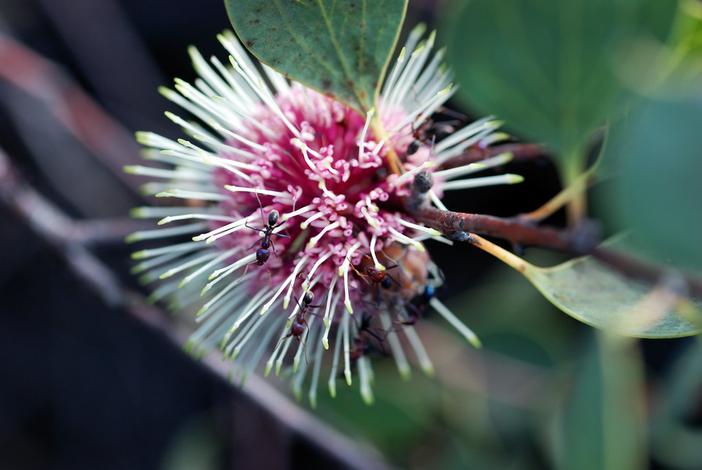Sea-Urchin Hakea
(Hakea petiolaris)
Sea-Urchin Hakea (Hakea petiolaris)
/
/

Jean and Fred Hort
CC BY 2.0
Image By:
Jean and Fred Hort
Recorded By:
Copyright:
CC BY 2.0
Copyright Notice:
Photo by: Jean and Fred Hort | License Type: CC BY 2.0 | License URL: https://creativecommons.org/licenses/by/2.0/ | Uploader: jeans_Photos | Publisher: Flickr






























Estimated Native Range
Summary
Hakea petiolaris, commonly known as the Sea-urchin Hakea, is a shrub or small tree that is part of the Proteaceae family, native to the sandplains and coastal regions of southwestern Australia. It typically grows up to 9 m (30 ft) in height and is characterized by its distinctive pale-grey leaves and erect form. The flowers, which are cream-coloured with pink or purple hues, are arranged in clusters and bloom in the austral autumn or winter. These flowers are somewhat showy, with dullish red clusters contrasted by white styles, and are followed by woody seed capsules that add to the plant’s ornamental value.
The Sea-urchin Hakea is valued for its fast growth rate, hardiness, and frost resistance. Its unique flower appearance and ability to attract birds make it a desirable feature plant in gardens. It is often used as a screening plant or hedge and can also be displayed as individual specimens. This species thrives in full sun and requires low amounts of water, making it suitable for xeriscaping. It prefers soils with fast drainage and is propagated from seed. While it is a hardy species, it can be susceptible to root rot if overwatered or planted in poorly drained soils. Gardeners should also be aware of its potential to become invasive if conditions allow for uncontrolled spread.CC BY-SA 4.0
The Sea-urchin Hakea is valued for its fast growth rate, hardiness, and frost resistance. Its unique flower appearance and ability to attract birds make it a desirable feature plant in gardens. It is often used as a screening plant or hedge and can also be displayed as individual specimens. This species thrives in full sun and requires low amounts of water, making it suitable for xeriscaping. It prefers soils with fast drainage and is propagated from seed. While it is a hardy species, it can be susceptible to root rot if overwatered or planted in poorly drained soils. Gardeners should also be aware of its potential to become invasive if conditions allow for uncontrolled spread.CC BY-SA 4.0
Plant Description
- Plant Type: Shrub, Tree
- Height: 15-25 feet
- Width: 15-25 feet
- Growth Rate: Moderate
- Flower Color: Cream, Pink, Purple
- Flowering Season: Fall, Winter
- Leaf Retention: Evergreen
Growth Requirements
- Sun: Full Sun
- Water: Low
- Drainage: Fast
Common Uses
Drought Tolerant, Low Maintenance, Showy Flowers
Natural Habitat
Native to the sandplains and coastal regions of southwestern Australia
Other Names
Common Names:
Scientific Names: , Hakea petiolaris,
GBIF Accepted Name: Hakea petiolaris Meisn.